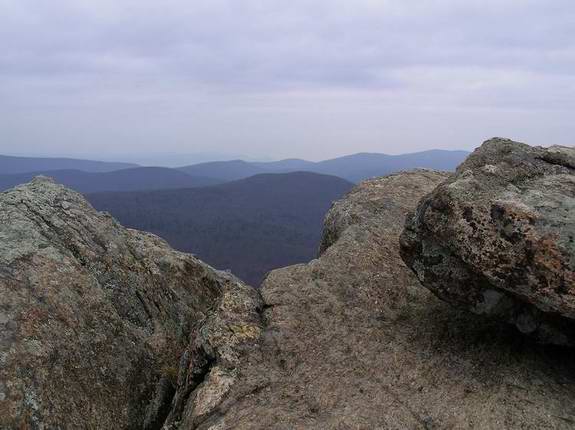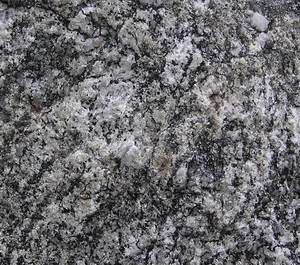|
Return to Hiker's Notebook Home Page
Geologic Formation: Pedlar Granodiorite and Granite-Gneiss
The Pedlar Formation is named for the Pedlar River which is a southward flowing tributary of the James River in Amherst County, Virginia, cutting through pre-Cambrian lithology. The Pedlar Formation was first identified and named as a key component of the this riparian system. The name Pedlar is ascribed to an elderly settler who perished in the river in about 1740. Pedlar is an alternative rendering of the word peddler which is from pedde, a covered basket from which merchandise was "peddled" or sold.
The igneous granodiorite and metamorphic granite-gneiss that make up the Pedlar Formation constitute the oldest rocks in Shenandoah National Park, dating from the Grenville orogeny about 1.2 billion years ago. According to the now widely accepted plate tectonic theory, all of the continents come together to form a supercontinent about every 500 million years; an orogeny is the mountain forming activities that accompany plate collisions. The Grenville orogeny occurred due to the collision of the Congo craton of the African Plate with the North American Plate, forming the supercontinent Rodinia; a craton is the stable portion of a tectonic plate that has historically survived collisions.
The inexorable force of the colliding North American and African plates created the pressure that resulted in the formation of the Grenville Mountains, the ancestral Appalachians; plutonic Pedlar granodiorite and Old Rag granite are its vestiges. Plutonic refers to an igneous rock formed by the intrusion of molten rock or magma into a preexisting rock (Pluto was the Roman god of the underworld, where this process occurs). The Pedlar Formation has extensive areas that show signs of having been distorted after the original igneous rock cooled whereas Old Rag Granite is not as distorted. The degree of distortion is the basis for the determination that the Pedlar Formation is the predecessor of Old Rag granite which is considered to have intruded into the older Pedlar rock.
Because of the variability of its metamorphism, the Pedlar Formation consists of areas that are predominantly igneous granodiorite and areas that are predominantly metamorphic granite-gneiss. Granodiorite is a phaneritic, intrusive, igneous rock. Phaneritic means that the essential minerals are at least one millimeter in size so that they can be individually distinguished without magnification; however, the slightly lustrous medium blue-gray granodiorite conveys a massive, undistinguished appearance. Granodiorite differs from the more plebian granite in the relative compositions of two key minerals: potassium or orthoclase feldspar and plagioclase feldspar, granodiorite having more of the latter. Granodiorite and granite both contain quartz and biotite mica. The terms orthoclase and plagioclase refer to the manner of fracture; in Greek, orthos is straight, plagios is oblique and klasis is break. This reflects the fact that orthoclase feldspar crystals have straight cleavage planes that are perpendicular and plagioclase feldspar crystals have two non-perpendicular cleavage planes.
The plagioclase feldspar that is the primary constituent of the Pedlar Formation granodiorite is actually a series of minerals with varying concentrations of key constituents that form what is known as a solid solution. When a liquid solution slowly cools, different minerals distinguished by the variance in their elemental composition solidify at different temperatures. The resultant solid rock is a solution of different minerals constituted according to the cooling rate. The primary plagioclase minerals are albite (NaAlSi3O8) and anorthite (CaAl2Si2O8); their relative percentage is used to characterize the nature of the plagioclase series. Feldspars are minerals comprised primarily of aluminum and silicon oxides; the name is essentially a German calque - feldspat means "field mineral." A spar is any crystalline nonmetallic mineral that readily cleaves into flakes. Feldspars make up about 60 percent of the earth's crust which is consistent with the crust's most common elements: oxygen 46.6 percent; silicon 27.7 percent; and aluminum 8.1 percent. The granite-gneiss rocks of the Pedlar Formation are those that were subject to metamorphosing forces of pressure and temperature to engender foliation, a recognizable planar array of mineral bands parallel to the predominant stress lines. The white granites are outlined with dark streaks of biotite and hornblende to produce a chiaroscuro that scintillates with light reflected from the mica and quartz. Gneiss (pronounced "nice") is derived from the Middle German gneiste, meaning spark.
|

